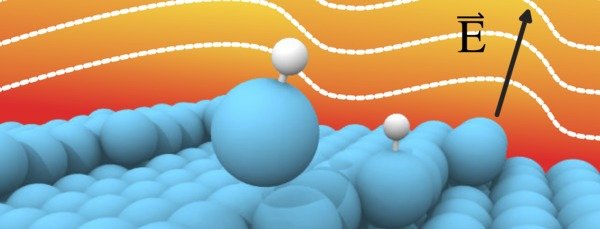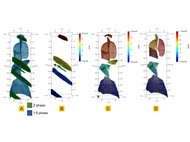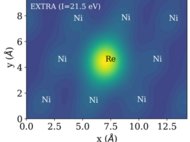
Field-Controlled Evaporation Mechanisms for Surface Atoms
Extremely strong (~10 V/nm) electric fields rupturing atomic bonds is a relatively well-studied concept in the field of molecular chemistry. When extended to crystalline systems, i.e. material surfaces, this concept is known as field evaporation and its exact mechanisms become more challenging to predict. Field evaporation is the central phenomenon that enables atom probe tomography (APT) and 3D field ion microscopy (3D-FIM), and obtaining atomically-accurate APT reconstructions will be impossible without an atomically-accurate understanding of how ions initially form and depart from the surface. By performing first-principles calculations on faceted surfaces under extreme fields, we search for such an understanding in pure metals and alloys.
We make use of our recently developed generalized dipole correction to accomodate very large, asymmetric electric fields in fully periodic density functional theory (DFT) calculations on slab structures. In experiment, atoms near low-coordinated features such as steps and kinks are the most relevant sites from which field evaporation takes place, as they experience a strong field enhancement due to the locally increased surface curvature. In order to reproduce the step and kink features in DFT models, the slab structures are generated for high Miller index surfaces. Figure 1 shows an example [10 8 1] slab generated for W, highlighting the kink atom whose evaporation we have studied.
![a) A 5-6 atomic layer [10 8 1] tungsten slab to which varying electric fields are applied during the sequential removal of a surface atom to simulate its evapora- tion. b) Top-down view of the uppermost layer of the [10 8 1] slab. The evaporating atom is shown in red.](/3887048/original-1548337269.jpg?t=eyJ3aWR0aCI6OTY2LCJvYmpfaWQiOjM4ODcwNDh9--7c329629fba6c855740e8a35b4e1c1f6b81293a4)
a) A 5-6 atomic layer [10 8 1] tungsten slab to which varying electric fields are applied during the sequential removal of a surface atom to simulate its evapora- tion. b) Top-down view of the uppermost layer of the [10 8 1] slab. The evaporating atom is shown in red.
We systematically remove this atom by increasing its z-coordinate, and repeat this process for a number of applied fields with varying strengths. Figure 2 shows how the system's energy varies as a function of the evaporating atom's z-coordinate for each of the applied fields.
The disruptions in the curvature of the energy profiles in Figure 2 are the result of changes taking place along the evaporation reaction coordinate. For distances where the evaporating atom is very close to its original position (<1.5 ̊Å), the energy fol- lows a smooth Morse-like trend. There is an abrupt shift to a new minimum between 1.5-2 Å; at this height the evaporating atom is sterically able to roll over into the nearest hollow site atop the neighboring terrace. The atom’s evaporation then proceeds from this new minimum in a manner very similar to a standard adatom. The second interruption in the energy vs. distance profile occurs when the original atom begins to pull up its nearest neighbor out of the step edge; at certain distances the two even form a dimer above the surface. This interaction near the surface is likely responsible for the substantial number of spatially correlated co-evaporation events observed during APT of W. At distances sufficiently high above the surface (>3.3 Å), this interaction becomes too weak to pull the neighboring atom up from its original position.
![Energy as a function of z-coordinate height above its original position for a kink corner atom on a [10 8 1] tungsten surface.](/3887347/original-1548337892.jpg?t=eyJ3aWR0aCI6OTY2LCJvYmpfaWQiOjM4ODczNDd9--c31b0b6f785399d2d621e7ad6d50895d80eae439)
Energy as a function of z-coordinate height above its original position for a kink corner atom on a [10 8 1] tungsten surface.
This multi-step mechanism gives rise to two dominant energy barriers to the overall evaporation process- the "rollover" barrier (~1.5 Å) between the original site and the local minimum atop the step edge, and then the "evaporation" barrier between this local minimum and the vacuum. The heights of these two barriers vary quite differently as a function of applied field, as shown in Figure 3.
![Energetic barriers as a function of applied electric field for the W [10 8 1] kink atom. Barrier 1 (blue) is the barrier to the initial rollover motion and Barrier 2 (orange) is the barrier to evaporation from the adatom site. Experimental data previously reported for tungsten is shown in black.](/3887109/original-1548337269.jpg?t=eyJ3aWR0aCI6OTY2LCJvYmpfaWQiOjM4ODcxMDl9--025b519aa1154447f108483a41b56e88d2cf0809)
Energetic barriers as a function of applied electric field for the W [10 8 1] kink atom. Barrier 1 (blue) is the barrier to the initial rollover motion and Barrier 2 (orange) is the barrier to evaporation from the adatom site. Experimental data previously reported for tungsten is shown in black.
Figure 3 shows that the overall barrier between the original site and the evaporated state (Δz → ∞) approaches zero as the applied field is increased, but does so asymptotically once the rollover barrier becomes rate-limiting. By extrapolating the barrier vs. field, we obtain a critical evaporation field close to 60 V/nm, in good agreement with experimentally applied fields for W evaporation.
These data show that experiments should be carried out at fields close to the critical evaporation field as possible. This is in order to avoid the scenario where an atom rolls over to the top of its neighboring step and has the freedom to diffuse to a new position before evaporating. The potential energy surface atop the W [1 1 0] step is very flat, and lateral walks performed prior to evaporation are untraceable in the final reconstruction of an APT experiment.
Similar results have been obtained for an Al [10 8 7] surface as well. This rollover mechanism appears to be ubiquitous in the case of metals, and further research will investigate the interaction of this mechanism with defects, alloying elements, and ultimately whether it has any analogs in semiconducting materials.
Currently, a systematic exploration of the field evaporation mechanisms and critical fields is being done for the metals that are technologically relevant. The effects of alloying additions and the presence of crystalline defects on field evaporation mechanisms are also being investigated. Additionally, to address the question of artefact vacancy generation in APT and FIM, defect formation energies under field are being calculated for metals and dilute alloys.
More projects from this group.
![a) A 5-6 atomic layer [10 8 1] tungsten slab to which varying electric fields are applied during the sequential removal of a surface atom to simulate its evapora- tion. b) Top-down view of the uppermost layer of the [10 8 1] slab. The evaporating atom is shown in red.
a) A 5-6 atomic layer [10 8 1] tungsten slab to which varying electric fields are applied during the sequential removal of a surface atom to simulate its evapora- tion. b) Top-down view of the uppermost layer of the [10 8 1] slab. The evaporating atom is shown in red.](/3887048/original-1548337269.jpg?t=eyJ3aWR0aCI6MzQxLCJmaWxlX2V4dGVuc2lvbiI6ImpwZyIsIm9ial9pZCI6Mzg4NzA0OH0%3D--dbd2d84f35be617809b3481b54f635715cd48621)
![Energy as a function of z-coordinate height above its original position for a kink corner atom on a [10 8 1] tungsten surface.
Energy as a function of z-coordinate height above its original position for a kink corner atom on a [10 8 1] tungsten surface.](/3887347/original-1548337892.jpg?t=eyJ3aWR0aCI6MzQxLCJmaWxlX2V4dGVuc2lvbiI6ImpwZyIsIm9ial9pZCI6Mzg4NzM0N30%3D--a165327da68e3940427402cc48ab5e43a058362e)
![Energetic barriers as a function of applied electric field for the W [10 8 1] kink atom. Barrier 1 (blue) is the barrier to the initial rollover motion and Barrier 2 (orange) is the barrier to evaporation from the adatom site. Experimental data previously reported for tungsten is shown in black.
Energetic barriers as a function of applied electric field for the W [10 8 1] kink atom. Barrier 1 (blue) is the barrier to the initial rollover motion and Barrier 2 (orange) is the barrier to evaporation from the adatom site. Experimental data previously reported for tungsten is shown in black.](/3887109/original-1548337269.jpg?t=eyJ3aWR0aCI6MzQxLCJmaWxlX2V4dGVuc2lvbiI6ImpwZyIsIm9ial9pZCI6Mzg4NzEwOX0%3D--71ddea6612740327f652daa7fc9ccc8ef9718c82)

